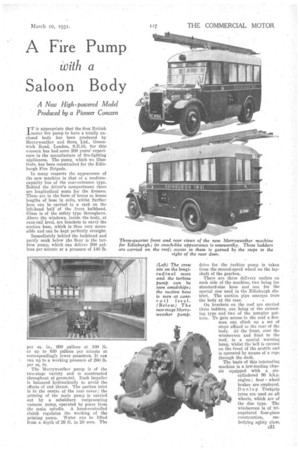A Fire Pump
Page 53

If you've noticed an error in this article please click here to report it so we can fix it.
with a
Saloon Body
A New High-powered Model Produced by a Pioneer Concern
IT is appropriate that the first British motor fire pump to have a totally enclosed body has been produced by Merryweather and Sons, Ltd., Greenwich Road, London, S.E.10, for this concern has had some 200 years' experience in the manufacture of fire-fighting appliances. The pump, which we illustrate, has been constructed for the Edinburgh Fire Brigade.
In many respects the appearance of the new machine is that of a mediumcapacity bus of the rear-entrance type. Behind the driver's compartment there are longitudinal seats for the firemen. These are in the form of boxes to house lengths of hose in coils, whilst further hose can be carried in a rack cm the left,hand half of the front bulkhead. Glass is of the safety type throughout. Above the windows, inside the body, at cant-rail level, are brackets to carry the suction hose, which is thus very accessible and can be kept perfectly straight.
Immediately behind the bulkhead and partly sunk below the floor is the turbine pump, which can deliver 500 gallons per minute at a pressure of 140 lb.
per sq. in., 690 gallons at 100 lb. or up to 830 gallons per minute at correspondingly lower pressures. It can run up to a working pressure of 290 lb. per sq. in.
The Merryweather pump is of the two-stage variety and is constructed throughout of gunmetal. Each impeller is balanced hydraulically to avoid the effects of end thrust. The suction inlet is in the centre of the rear cover; the priming of the main pump is carried out by a subsidiary reciprocating vacuum pump, operated by gears from the main spindle. A hand-controlled clutch regulates the working of the priming pump. Water can be lifted from a depth of 26 ft. in 20 secs. The drive for the turbine pump is taken from the second-speed wheel on the layshaft of the gearbox.
There are three delivery outlets on each side of the machine, two being for standard-size hose and one for the special size used in the Edinburgh district. The suction pipe emerges from the body at the rear.
On brackets on the roof are carried three ladders, one being of the extending type and two of the pornpier pattern. To gain access to the roof a fireman can climb up a set of steps affixed to the rear of the body. At the front, over the windscreen and fixed to the roof, is a special warning lamp, whilst the bell is carried on the front of the scuttle and is operated by means of a rope through the dash. The basis of this interesting machine is a low-loading chassis equipped with a sixcylbidered 90 b.b.p. engine; four wheel brakes are employed. Dunlop Trakgrip tyres are used on all wheels, which are of the disc type. The windscreen is of triangulated four-piece
construction, embodying stfety glass.












































































































